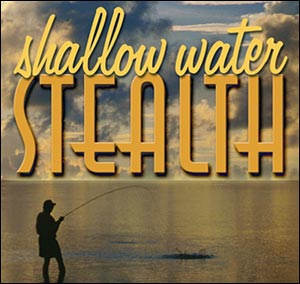
An angler's manual to sight-casting
for reds on the flats.
By Paul A. Cañada
Finally, we spied a pod of fish before
I accidentally alerted them of our position. The backs of three fish,
slowly cruising an inside grass line, were about 30 yards down the
shoreline from Bob and me. He gambled that the slight riffle on the
water surface would make a 20- to 25-foot cast possible.
Holding the bantam-sized diver in my
near-trembling line hand, I quietly awaited the fish's approach.
"Don't overpower the cast, don't overpower the cast,"
I quietly whispered. "If you overpower the cast you're
going to spook 'em again."
Speaking very softly, Bob instructed,
"It's time, now or never."
Tips
- Areas with a variety of habitat are more likely to hold baitfish, and as a result, redfish.
- While stalking redfish, the shallower
the water, the quieter you must be.
- Avoid a bad encounter with a stingray by sliding or "shuffling"
your feet along the bottom.
- The best place to sight a red is the line where vegetation starts and
the sand ends.
- If you can hear yourself pushing water
while stalking, you're probably walking too fast.
|
I let the fly go and slowly lifted the 15 feet of fly line laying at my feet off the water and into the air.
I used the first casting stroke to measure the distance. The second
cast sent the weight forward line sailing to the target. "Darn,"
I said with a sigh, "I overpowered the cast."
Amazingly, the small pod of redfish
stayed the course. The fish drew within a yard or so of the diver
before I made my first hard strip. Bloop, bloop - the purple diver
plunged forward. In a mighty swirl of water, the diver was gone.
Immediately, the fly line jumped off the water surface and then off
my spool.
"Finally," I shouted, "sweet
success."
I still remember that first redfish.
Of course, my success was due mostly to the patience and valuable
instruction of a good friend, and the appetite of a 22-inch redfish.
When sight-casting to shallow redfish,
the angler has to do a number of things right. A single mistake in
approach or the placement of the cast and the cautious redfish is
gone. Thankfully, three of Texas' better flats guides - Eric
Glass, R.J. Shelly and Elton Hudson - have taken the time to
provide you (and me) with some solid advice on the art of stalking
and sight-casting to shallow reds. Practice the following principles
and your catch rate will surely climb.
Choose prime real estate
As is the case with all forms of
angling, the sight-casting journey begins with the final destination.
That is, the angler must first find the most promising water. This
concept, locating productive water, is more critical to the wade
fisherman simply because the angler's mobility is greatly
reduced. Ideally, the wading angler wants to select an area that
holds the greatest number of redfish in the smallest section of
water.
After carefully considering both
weather and water conditions, the smart angler first eliminates the
more unlikely areas. Top guides like South Laguna Madre's Eric
Glass also consider water depth and clarity, prevailing tides and
wind speed and direction when selecting wading water. After carefully
considering environmental conditions, Glass targets those areas that
are protected, have a variety of water depth and habitat, and of
course, plenty of prey.
According to Glass, the west side of
the southernmost portion of the Laguna Madre is one such area. "There
are more varieties of grasses and more relief on the west side of the
bay," he says. "I like to fish flats that have a
drop-off - like a channel or old well cut - within 1/4- to
1/2-mile of the shallowest water."
A variety of grasses, bottom
composition and water depth typically support a greater variety of
life forms. Not surprisingly, those areas with the greatest variety
of habitat often hold the greatest number of redfish. Furthermore,
when tides and conditions change, wading anglers needn't go very
far to stay in touch with the fish.
"The general pattern in
summertime," explains Glass, "is for the redfish to move up
on the crown of the flat early. The fish will actively feed - tailing
or cruising with their backs out of the water - until late
morning. The fish then move out to the deeper water found in the
nearest drop-off. Because of this, I find the fish on these ideal
flats - with deep water in close proximity - more predictable
and easier to pattern day after day."
Conversely, Glass finds that
shorelines with extensive flats and deep water a good distance away
are often tougher to pattern. There's simply too much shallow
water to cover so it's much harder to locate numbers of fish.
More importantly, it's difficult to know just exactly where the
fish will be from day to day.
continued
page 1 / page 2
| 




